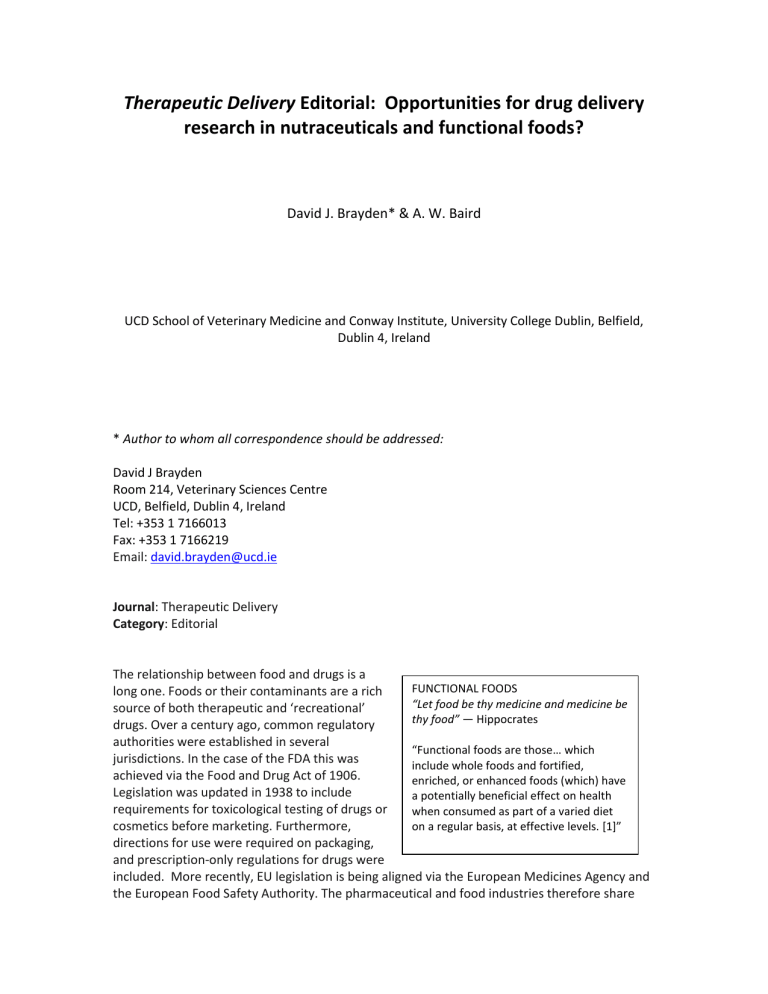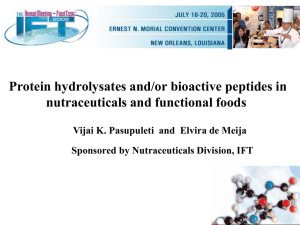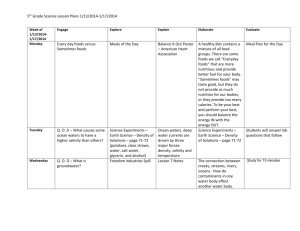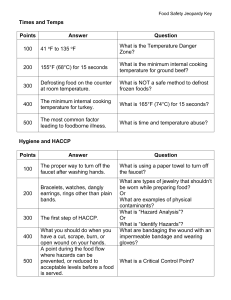Commentary_Brayden_&_Baird_15112012

Therapeutic Delivery Editorial: Opportunities for drug delivery research in nutraceuticals and functional foods?
David J. Brayden* & A. W. Baird
UCD School of Veterinary Medicine and Conway Institute, University College Dublin, Belfield,
Dublin 4, Ireland
* Author to whom all correspondence should be addressed:
David J Brayden
Room 214, Veterinary Sciences Centre
UCD, Belfield, Dublin 4, Ireland
Tel: +353 1 7166013
Fax: +353 1 7166219
Email: david.brayden@ucd.ie
Journal: Therapeutic Delivery
Category: Editorial
The relationship between food and drugs is a long one. Foods or their contaminants are a rich source of both therapeutic and ‘recreational’ drugs. Over a century ago, common regulatory authorities were established in several jurisdictions. In the case of the FDA this was achieved via the Food and Drug Act of 1906.
FUNCTIONAL FOODS
“Let food be thy medicine and medicine be
thy food” ― Hippocrates
Legislation was updated in 1938 to include requirements for toxicological testing of drugs or cosmetics before marketing. Furthermore, directions for use were required on packaging,
“Functional foods are those… which include whole foods and fortified, enriched, or enhanced foods (which) have a potentially beneficial effect on health when consumed as part of a varied diet on a regular basis, at effective levels. [1]” and prescription-only regulations for drugs were included. More recently, EU legislation is being aligned via the European Medicines Agency and the European Food Safety Authority. The pharmaceutical and food industries therefore share
certain challenges with respect to legislation and regulation. While all foods, by definition, are functional if they are bioavailable, the term ‘Functional Food’ has become widely used to delineate the add-on benefits of fortification of the natural product. Similarly, ‘Nutraceuticals’ have become widely recognized as a term to describe foods or food-derived components for which health claims have been associated [101] in order to achieve marketing goals within regulatory constraints [2].
Nutraceuticals may be broadly defined. They include conventional foods, modified foods,
‘medical’ foods and foods for special dietary use. In the absence of a clear definition of functional food, there is a blurring of the distinction between foodstuff, drugs and even medicaldevices. Nutraceutical payloads include dietary supplements (minerals, vitamins, amino acids, enzymes), bioactive peptides, as well as fatty acids, antioxidants and flavonoids. Typically, they are formulated into powders, tablets, liquids or gelatin capsules. Functional- and medical foods are separate research branches, which are designed as respective foods for both nutritional benefit (e.g. probiotic yoghurts), or with beneficial concentrated biomolecules added (e.g.
Ensure ® , Abbott Nutrition).
The nutraceutical industry is expanding and global sales are predicted to achieve $180 B by 2017 [102], which part-explains why Pharma and Biotech companies are committing significant resources to it. A major problem however, is that nutraceutical labeling in the US does not come under the regulation of FDA and lack of substantiation of health claims has led to concerns regarding claims of efficacy. Although drug delivery scientists have a key role to play in enabling incorporation of nutraceutical molecules or mixtures into oral formulations, it is notable that this is not yet significantly reflected in the conference programming of two of the main relevant societies for delivery technology, the
Controlled Release Society and the American Association for Pharmaceutical Scientists. What are the specific areas of nutraceutical and functional food research that delivery scientists can contribute to?
Delivery scientists can provide delivery bioassays
One feature which is unhelpful is the way in which the term ‘oral bioavailability’ has evolved to have different meanings for pharmaceutical and for food scientists [3]. The same factors influence bioavailability of pharmaceuticals and of nutrients. These include intestinal physiological, anatomical and biochemical features which, if understood, can be considered appropriately, The pharmaceutical and food industry have generated molecules with health potential, but which have limited value as a consequence of restrictive ADME profiles. The challenges include metabolic instability and restricted intestinal permeability. Food-derived peptides with therapeutic attributes may eventually become useful, assuming a requirement for systemic absorption, if they can be orally formulated to avoid digestion and to enable intestinal permeability. These hurdles account for the fairly limited clinical success of oral peptides to date due largely to poor efficacy arising from large intra-subject variation [4]. Foltz and colleagues have argued that in vivo pharmacological testing of food-derived oral bioactive peptides for health benefit is of limited use in the absence of pharmacokinetic (PK) data and appropriate design of dosing levels and regimes [5]. Knowledge of metabolic stability and the mechanisms of permeation across the intestine of the payload in vivo is essential for modifying bioavailability of peptides. For poorly absorbed small molecules, issues of poor permeability and/or solubility may be addressed through a reductionist approach, using validated methods and tailored bioassays to anticipate PK profiles. However, the concept of ‘bioefficacy’ is one which might be useful for food scientists since this represents the ‘net outcome’ on an individual by combining
2
analysis of PK with pharmacodynamics (PD). With careful study design and statistical analysis, bioefficacy methodology may be a predictor of genuine health benefits in the real-world situation [3].
Milk-derived bioactives: a story that doesn’t quite tally
An interesting example of a foodstuff with complex properties is mammalian milk. In the case of bovine milk for human consumption, this represents a product of genetic engineering achieved over thousands of years of domestication [6]. Milk contains a mixture of substances, including those which are pharmacologically active [7]. A feature of the natural history of mammals is that milk has been evolved for benefits of the neonate. At such a stage of development intestinal physiology of the infant is quite different from that of the adult. Consequently, for example, protective maternal immunoglobulins secreted in milk enter the systemic circulation of neonates before ‘closure’ of the intestinal wall. In the case of adults who drink milk, much of the
(nutritional) benefit is dependent upon digestion of the proteins, carbohydrates and lipids to absorbable formats. Some, milk-derived oligosaccharides act within the lumen of the gut and are not therefore absorbed [8]. Other pharmacologically active substances in milk also include casomorphins and peptides which alter blood flow. For example, the anti-hypertensive prolinerich casein-derived tripeptides, Ile-Pro-Pro (IPP) and Val-Pro-Pro (VPP), exert angiotensinconverting enzyme type 1 (ACE) inhibitory actions [9]. A recent report suggest that a low-fat functional food spread containing the peptides and plant sterols can modestly reduce systolic blood pressure and LDL cholesterol in hypertensive human subjects following a 10 week study
[10], and that long term oral dosing with a sour milk product containing the peptides can reduce systolic blood pressure by up to 7mm Hg [11]. A marketed sour milk product, Evolus ® (Valio,
Finland), also contains VPP and IPP and there are associated website claims to the effect that it can assist in ‘controlling’ blood pressure [103], These claims are unlikely to have been assessed by any regulatory authority to date. Moreover, clinical data on the blood pressure reduction induced by these tripeptides does not correlate with in vitro permeability parameters, where the apparent permeability coefficients (Papp) of VPP and IPP across Caco-2 monolayers and isolated rat jejunal mucosae were extremely low [12]. Furthermore, when IPP was administered intra-gastrically in saline to pigs, only 0.1% bioavailability was achieved and it was associated with a very short terminal elimination t½ [13]. It may be that the apparent ‘bioefficacy’ of VPP seen in vivo was a consequence of significant solvent drag-induced passive paracellular flux of intact peptide through epithelial tight junctions, a pathway poorly modelled in Caco-2 monolayers [14] . Although proline residues are thought to confer intestinal stability, it seems that this protection does not apply in the event that the peptides are absorbed by small intestinal enterocytes and are exposed to membrane and cytosolic peptidases. In addition to PK data suggesting low and transient oral bioavailability, it turns out that the tripeptides are not even very potent ACE inhibitors [15], so additional pharmacological explanations are required to explain their modest mechanism of action in blood pressure reduction.
Many potentially useful therapeutic peptides are limited by low bioavailability. Of the thousands evaluated, only two (structurally atypical) molecules, arginine vasopressin and cyclosporine, are currently approved as efficacious in oral formats. In vitro permeability studies, in vivo rat intestinal region instillations and oral rat and pig PK studies have provided information that can inform subsequent formulation efforts designed to increase peptide oral bioavailability to achieve pharmacodynamic outcomes. Oral drug delivery scientists can add scientific value to these aspects of nutraceutical research and, if improved bioavailability is needed for poorly
3
permeable, unstable or insoluble molecules, then they can provide the rationale for a particular formulation approach.
Drug delivery: probiotics, minerals, fatty acids and vitamins
Controlled release microencapsulation (ME) technologies are also used to incorporate bioactive ingredients in functional foods [16]. For probiotics, one of the issues is to deliver a high proportion of viable bacteria to the colon for local but not systemic effects. There is some clinical evidence that certain strains of lactobacillus can provide benefits in irritable bowel disorder [17]. There is also continuing interest in delivering bacteria which code for local production of anti-inflammatory molecules, which have achieved efficacy in murine models of colitis [ 18 ]. Many of the unique formulation issues for spray coating and microencapsulation of prebiotics and probiotics have been outlined [19]. These include a requirement to use of foodgrade materials and approved excipients, delivery into food matrices without loss of function, lack of a taste effect, the challenge of keeping cells alive during the encapsulation and storage, and formulation designs to release in the colon. Technologies showing promise for ME of probiotics include incorporation in chitosan-coated alginate gels [ 20 ]. While this approach seems to avoid direct stomach acid and bile exposure for the probiotic formulated and presented in either a functional food or a nutraceutical format, reproducible delivery of high quantities of viable bacteria to the colon remains elusive, despite the impression given by marketing departments from dairy companies. Colonic delivery of probiotics is therefore another area where drug delivery scientists have developed understanding and methodologies with which to assist formulation design [ 21 ]. Food grade nanoemulsions are also being used for oral absorption of bioactive lipids [22]. In addition, vitamins and minerals can be incorporated into food matrices and examples of technologies include calcium salts in liposomes made from lecithin that could be presented in fortified soya milk [reviewed in 23 ], as well as omega-3 fatty acids in spray dried emulsions, which offset taste and smell issues [ 24 ]. Food grade delivery systems have been classified under criteria of production method, stability in storage, physicochemical properties, sensory properties and site of delivery in the alimentary canal [25].
Perhaps the most interesting for delivery scientists are the range of compositions and formats
(Table 1). A good example of applying oral drug delivery technology to nutraceuticals/medical foods is the development of a vitamin B12 formulation in B12-deficient subjects using
Emisphere’s (Tarrytown, NJ, USA) Eligen® carrier technology, which has led to their first product
[26, 104]. This was aided by extensive toxicology on the carrier, which allowed the carrier to be designated as a ‘generally regarded as safe’ (GRAS) excipient that could be combined with nutrients [27]. Because the carrier combines in a non-covalent fashion to B12, Eligen ® formulations in theory contain no new chemical entities and this may eventually assist the regulatory path for pharmaceuticals using that technology.
Drug delivery and formulation of food-derived small molecules
Coordination of drug administration with food ingestion is common (“Take three times a day after meals”) and food interactions with established drugs are important [28]. However, this is not always negative. For example, a high-fat rather than low-fat salad dressing contains excipients that increase absorption, and consequently bioefficacy, of carotenes [29]. A common condiment and spice, curcumin is a polyphenol phytochemical isolated from turmeric with possible anti-cancer and anti-inflammatory potential [30]. It is isolated from isolated from the rhizomes of Curcuma longa Linn. (Zingiberaceae) and has long been used in traditional medicine.
This hydrophobic molecule has unappealing physicochemical properties that result in very low
4
oral PK due to poor aqueous solubility, instability in the GI tract and permeability issues.
Consequently, it is currently impossible to examine its full potential in vivo. Approaches to rectify this include formulation in liposomes, biodegradable nanoparticles, solid-lipid nanoparticles, or cyclodextrins, along with attempts to make analogues with improved physicochemical properties [31]. Similar formulation opportunities may arise for other interesting polyphenol phytochemicals with clinical potential including catechins and theaflavins from green tea [ 32 ], as well as anti-oxidants from grape skin and seed extracts [ 33 ]. Returning to milk as a source of useful molecules, there is good evidence of bactericidal effects of fatty acids
[34] which are present in plant- and animal-derived foodstuffs in the form of ratios of natural medium- and chain fatty acids. These GRAS agents have a broad spectrum antibacterial activity and a low propensity to induce bacterial resistance and are being developed as topical microbicides [35]. It seems that models, data and concepts emanating from drug delivery research may be extended more widely.
Conclusions
Drug delivery opportunities exist in the burgeoning science of nutraceuticals and functional foods. Formulation of individual molecules or mixtures for medicinal use can exploit a large range of biocompatible materials, food grade excipients and processes. Drug delivery researchers and food scientists may share PK profiling data and bioefficacy monitoring in order to inform formulation design of nutraceuticals. To date, interactions between food scientists and drug delivery researchers have been far too limited. At a time when diet has become a principal factor in aetiology of disease in many countries, it is ironic that we are looking to foodstuffs for health benefit. However, much of the world’s population remains dependent upon herbal remedies. Of interest is that ‘Food and health’ research has become increasingly fundable and is a national priority area of research in several countries [105], and nutraceutical research now has the increasing attention of industry. Formulation and delivery research will be central to translation to products. Traditional pharmacological approaches will continue provide the mechanistic and rational basis for possible medicinal claims of functional foods and nutraceuticals.
Financial and competing interest disclosure
Bioavailability research on food-derived peptides is funded in the laboratory of the authors by an Irish Department of Agriculture’s Food Institutional Research Measure (FIRM) grant and an
Enterprise Ireland grant (Food for Health Ireland). AWB is a founder of Capstan Healthcare Ltd, a start-up veterinary healthcare company providing technology and product development services. DJB has no competing and financial interests.
Bibliography
1. Hasler CM, Brown AC. Position of the American Dietetic Association: functional foods. J
2.
Am Dietetic Association109:735-746 (2009).
Hasler CM. Regulation of functional foods and nutraceuticals : a global perspective, IFT
3.
Press. Blackwell Pub., Chicago, Il. Ames, Iowa, (2005).
Rein MJ, Renouf M, Cruz-Hernandez C, Actis-Goretta L, Thakkar SK, da Silva Pinto M.
Bioavailability of bioactive food compounds: A challenging journey to bioefficacy. Br J
Clin Pharmacol (2012). doi: 10.1111/j.1365-2125.2012.04425.x. In Press.
5
4.
5.
6.
7.
Maher S, Brayden, D J. Overcoming poor permeabilities: translating permeation enhancers for oral peptide delivery. Drug Discovery Today Technologies, 9 (2), e-113e119 (2012).
Folz M, van der Pijl PC, Duchateua G. Current in vitro testing of bioactive peptides is not valuable. J Nutrition 140, 117-118 (2009).
Flint AP, Woolliams JA. Precision animal breeding. Phil Trans Royal Soc London Series B,
Biological Sciences 363, 573-590 (2008).
Shah, NP. Effects of milk-derived bioactives: an overview. Br J Nutrition 84, Suppl 1:S3-
10 (2000).
Zivkovic AM, Barile D. Bovine milk as a source of functional oligosaccharides for 8.
9. improving human health. Adv Nutr 2:284-289 (2011).
Siltari A, Kivimäki AS, Ehlers PI, Korpela R, Vapaatalo H. Effects of milk casein derived tripeptides on endothelial enzymes in vitro; a study with synthetic tripeptides.
Arzneimittelforschung 62, 477-481 (2012).
10. Turpeinen AM, Ikonen M, Kivimäki AS, Kautiainen H, Vapaatalo H, Korpela R. A spread containing bioactive milk peptides Ile-Pro-Pro and Val-Pro-Pro, and plant sterols has antihypertensive and cholesterol-lowering effects. Food Funct 3, 621-627 (2012).
11. Seppo L, Jauhiainen T, Poussa T, Korpela R. A fermented milk high in bioactive peptides has a blood pressure-lowering effect in hypertensive subjects. Am J Clin Nutr 77, 326-
330 (2003).
12. Foltz M, Cerstiaens A, van Meensel A, Mols R, van der Pijl PC, Duchateau GS, Augustijns
P.The angiotensin converting enzyme inhibitory tripeptides Ile-Pro-Pro and Val-Pro-Pro show increasing permeabilities with increasing physiological relevance of absorption models. Peptides 29, 1312-1320 (2008).
13. van der Pijl PC, Kies AK, Ten Have GA, Duchateau GS, Deutz NE.Pharmacokinetics of proline-rich tripeptides in the pig. Peptides 29, 2196-2202 (2008).
14. Satake M, Enjoh M, Nakamura Y, Takano T, Kawamura Y, Arai S, Shimizu M.
Transepithelial transport of the bioactive tripeptide, Val-Pro-Pro, in human intestinal
Caco-2 cell monolayers. Biosci Biotechnol Biochem 66, 378-384 (2002).
15. Tuomilehto J, Lindström J, Hyyrynen J, Korpela R, Karhunen ML, Mikkola L, Jauhiainen T,
Seppo L, Nissinen A.Effect of ingesting sour milk fermented using Lactobacillus helveticus bacteria producing tripeptides on blood pressure in subjects with mild hypertension. J Hum Hypertens 18, 795-802 (2004).
16. Kuang SS, Oliveira JC, Crean AM. Microencapsulation as a tool for incorporating bioactive ingredients into food. Crit Rev Food Sci Nutr 50, 951-968 (2010).
17. Clarke G, Cryan JF, Dinan, TG, Quigley, EM. Review article: probiotics for the treatment of irritable bowel syndrome-focus on lactic acid bacteria. Aliment Pharmacol Ther 35,
403-413 (2012).
18. Carroll IM, Andrus JM, Bruno-Bárcena JM, Klaenhammer TR, Hassan HM, Threadgill DS.
Anti-inflammatory properties of Lactobacillus gasseri expressing manganese superoxide dismutase using the interleukin 10-deficient mouse model of colitis. Am J Physiol 293,
G729-38 (2007).
19. Champagne CP, Fustier P. Microencapsulation for the improved delivery of bioactive compounds into foods. Current Opinion in Biotechnology 18, 184-190 (2007).
20. Chandramouli V, Kailasapathy K, Peiris P, Jones M. An improved method of microencapsulation and its evaluation to protect Lactobacillus spp. in simulated gastric conditions. J Microbiol Methods 56, 27-35 (2004).
6
21. Prakash S, Tomaro-Duchesneau C, Saha S, Cantor A. The gut microbiota and human health with an emphasis on the use of microencapsulated cells. J. Biomedicine and
Biotechnology, Article ID 981214 (2011).
22. McClements DJ, Rao J. Food-grade nanoemulsions: formulation, fabrication, properties, performance, biological fate, and potential toxicity. Crit Reviews in Food Science and
Nutrition 51, 285-330 (2011).
23. Schrooyen PMM, van der Meer R, De Kruif CG. Microencapsulation: its application in nutrition. Proc. Nutrition Society 60, 475-479 (2001).
24. Shaw LA, McClements DJ, Decker EA. Spray-dried multilayered emulsions as a delivery method for omega-3 fatty acids into food systems. J Agric Food Chem 55, 3112-3119
(2007).
25.
Benshitrit RC, Levi CS, Tal SL, Shimoni E, Lesmes U. Development of oral food-grade delivery systems: current knowledge and future challenges. Food Funct 3, 10-21 (2012).
26. Castelli MC, Wong DF, Friedman K, Riley MG. Pharmacokinetics of oral cyanocobalamin formulated with sodium N-[8-(2-hydroxybenzoyl)amino]caprylate (SNAC): an open-label, randomized, single-dose, parallel-group study in healthy male subjects. Clin Ther 33,
934-945 (2011).
27. Riley MG, Castelli MC, Paehler EA. Subchronic oral toxicity of salcaprozate sodium
(SNAC) in Sprague-Dawley and Wistar rats. Int J Toxicol 28, 278-293 (2009).
28. Yasuji T, Kondo H, Sako K. The effect of food on the oral bioavailability of drugs: a review of current developments and pharmaceutical technologies for pharmacokinetic control. Therapeutic Delivery 3, 81-90 (2012).
29. Brown MJ, Ferruzzi MG, Nguyen ML, Cooper DA, Eldridge AL, Schwartz SJ, White WS.
Carotenoid bioavailability is higher from salads ingested with full-fat than with fatreduced salad dressings as measured with electrochemical detection. American J Cinical
Nutrition 80, 396-403 (2004).
30. Anand P, Kunnumakkara AB, Newman RA, Aggarwal BB. Bioavailability of curcumin: problems and promises. Molecular Pharmaceutics 4, 807-818 (2007).
31. Mohanty C, Das M, Sahoo SK. Emerging role of nanocarriers to increase the solubility and bioavailability of curcumin. Expert Opin Drug Deliv 9, 1347-1364 (2012).
32. Kanwar J, Taskeen M, Mohammad I, Huo C, Chan TH, Dou QP. Recent advances on tea polyphenols. Front Biosci 4:111-131 (2012).
33. Zhou K., Raffoul JJ. Potential anticancer properties of grapes. J. Oncology, Article ID
803294 (2012)
34. Knapp HR, Melly MA. . Bactericidal effects of polyunsaturated fatty acids. J. Infect Dis
154, 84-94 (1986).
35. Desbois AP, Smith VJ. Antibacterial free fatty acids: activities, mechanisms of action and biotechnological potential. Applied Microbiology and Biotechnology 85,1629-1642
(2010).
Websites
101. Health Canada’s policy paper on the association of ‘nutraceutical’ and ‘functional foods’ with health benefits. http://www.hc-sc.gc.ca/fn-an/alt_formats/hpfb-dgpsa/pdf/labeletiquet/nutra-funct_foods-nutra-fonct_aliment-eng.pdf
. Accessed January 29 th , 2013.
102. Market Report. Nutraceuticals market to 2017 - Food additives such as omega-3 fatty acids, probiotics, soy and energy drinks to perform strongly.
7
http://www.marketresearch.com/GBI-Research-v3759/Nutraceuticals-Food-Additives-Omega-
Fatty-6511079/ GBi Research. (2011). Accessed November 15 th , 2012
103. Claims that Evolus ® controls blood pressure. http://ammattilaiset.valio.fi/portal/page/portal/valiocom/Company_information/Products_Inte rnational_Sales/functional_products18102006164724/valio_evolus_double_effect_products050
92008150615 . Accessed November 15 th , 2012.
104. Emisphere’s commercialisation of an oral vitamin B12 supplement as a medical food. http://ir.emisphere.com/releasedetail.cfm?ReleaseID=414664 . Accessed November 15 th , 2012.
105. ‘Food and health’ research is now one of Ireland’s priority funding areas (p. 12). http://www.djei.ie/publications/science/2012/research_prioritisation.pdf
. Accessed November
15 th , 2012.
Table 1. Drug delivery systems to entrap bioactive ingredients
Technologies
(Selected)
Advantages Disadvantages
Lipid-based
-Emulsions
-Nanogels
-Solid lipid
-Liposomes
-Triglycerides
Protein-based
-Gelatin
-Casein
-Whey
-Soy hydrogels
-Gliadin
Carbohydrate-based
-Starch/corn starch
-Pectin
-Guar gum
-Cyclodextrins
-Alginate
-Chitosan
-Wetting and dissolution
-Solubilization
-Wide diameter range
-Lipid coatings
-Versatile
-Cheap
-Simple process
-Safety profile
-Nano-sizing
-Bioresponsive
-Colonic delivery
-Increase solubility
-Improve protection
-Nano-sizing
-Taste masking
-Complex processes in some cases
-Limited cargo types
-Allergy risk
-Flavour issues
-Cargo compatibility
-In vivo data scant
Data derived from material cited in Refs [22, 23, 25]
Examples
-Lipids
-Fat soluble vitamins
-Polyunsaturated fatty acids
-Vitamin D
-Green tea derivatives
-Polyphenols
-Carotenoids
-Isoflavones
-Omega-3 fatty acids
-Curcumin
-D-limonene
-Probiotics
8









